Popular categories
Looking for a yarn?
High Tide
Knitted shawl with lace and wave pattern. The piece is worked top down in DROPS Lace.
DROPS Design: Pattern no la-036
Yarn group A
-----------------------------------------------------------
Measurements: Height measured along the mid-stitch is approx. 64 cm / 25¼" and width measured along the top is approx. 180 cm / 70¾".
Materials:
DROPS LACE from Garnstudio (belongs to yarn group A)
100 g color 6790, royal blue
The piece can also be knitted with yarn from:
"Alternative yarn (Yarn group A)" – see link below.
DROPS CIRCULAR NEEDLE (80 cm / 32") SIZE 3 mm/US 2.5 – or the size needed to get 24 stitches and 32 rows stockinette stitch on 10 cm / 4" in width and 10 cm / 4" in height.
KNITTING GAUGE:
The shawl will be dampened and stretched after the final measurements, so the knitting gauge is not so important. But to give yourself an idea about whether you are working too loosely or too tightly, you can work a test square in stockinette stitch with needle size 3 mm / US 2.5 to see if the knitting gauge is right.
-------------------------------------------------------
Alternative Yarn – See how to change yarns here
Yarn Groups A to F – Use the same pattern and change the yarn here
Yarn usage using an alternative yarn – Use our yarn converter here
-------------------------------------------------------
- English (US/in)
- Česky - not translated
- Dansk
- Deutsch
- Eesti keel
- English (UK/cm)
- Español
- Français
- Íslenska
- Italiano
- Magyar
- Nederlands
- Norsk
- Polski
- Português
- Suomi
- Svenska
- English (UK/cm), Bulgaria
- English (UK/cm), Croatia
- English (UK/cm), Greece
- English (UK/cm), Latvia
- English (UK/cm), Lithuania
- English (UK/cm), Romania
- English (UK/cm), Slovenia
- Česky, Slovakia - not translated
Pattern instructions
RIDGE/GARTER STITCH (worked back and forth):
1 ridge = Knit 2 rows.
PATTERN:
See diagrams A.1 to A.7. The diagrams show all the rows in the pattern seen from the right side.
BINDING OFF TIP
To avoid the bind-off edge being tight you can make yarn overs at the same time as you bind off. Make yarn overs above all the yarn overs from the previous row with yarn overs; the yarn overs are then bind off as normal stitches. Make sure you do not tighten the strand. If the bind-off edge is still tight, you can use a larger needle size to bind off.
SHAPING:
If you are using another yarn from yarn group A, the shawl will not need to be stretched when finished; but dampen it and lay it flat in the right shape. Allow it to dry. Repeat this process each time the shawl is washed.
----------------------------------------------------------
SHAWL:
The piece is worked back and forth with circular needle to give enough room for all the stitches. It is worked top down. Cast on 5 stitches with circular needle size 3 mm / US 2.5 and Lace. Now work the next 2 rows as follows:
ROW 1 (= right side): Work 1 edge stitch in GARTER STITCH - see description above, 1 yarn over, 1 stitch in stockinette stitch, 1 yarn over, 1 stitch in stockinette stitch, 1 yarn over, 1 stitch in stockinette stitch, 1 yarn over and 1 edge stitch in garter stitch.
ROW 2 (= wrong side): 2 edge stitches in garter stitch, purl until there are 2 stitches left and 2 edge stitches in garter stitch = 9 stitches on the needle.
Then work according to diagrams A.1 and A.2 as follows: Work diagram A.1 over the first 4 stitches, 1 stitch in stockinette stitch (= mid-stitch - this is worked in stockinette stitch throughout the whole piece), work A.2 over the last 4 stitches. Continue working like this according to A.1 and A.2 until the diagrams have been worked 1 time in height = 81 stitches on the needle.
READ THE WHOLE OF THE NEXT SECTION BEFORE CONTINUING!
Now you will continue with pattern and increases in the same way as in A1 and A.2.
You are increasing 2 stitches at the beginning and end of the row and increasing on each side of the mid-stitch. The row of holes is worked in the same way; it is important to make sure the rows of holes are above each other (as before) and that there are at least 5 stitches stockinette stitch on each side of the mid-stitch. Work like this until you have increased a total of 54 times and there are 333 stitches on the needle (= 166 stitches on each side of the mid-stitch).
Now continue as follows on the next row from the right side:
Work diagram A.3 over 4 stitches, repeat diagram A.4 over the next 156 stitches (= 12 repeats in width), work A.5 over 6 stitches, 1 stitch in stockinette stitch (= mid-stitch), A.6 over 6 stitches, repeat diagram A.4 over the next 156 stitches (= 12 repeats in width), work A.7 over the last 4 stitches. Work the diagrams like this 1 time in height = 555 stitches on the needle.
Work 2 ridges. READ BINDING OFF TIP and bind off with knit on the next row. Cut and fasten the strand.
STRETCHING:
Place the shawl in luke-warm water until it is thoroughly wet. Press the water carefully out of the shawl - do not twist the garment, then roll the shawl in a towel and press to remove even more water - the shawl should just be damp. If you have used another yarn from yarn group A, read SHAPING above. Lay the shawl on a floor rug or mattress - pull it gently into shape and use pins to fasten it down. Allow the shawl to dry. Repeat the process each time the shawl is washed.
Diagram
All measurements in charts are in cm.

|
= knit from right side, purl from wrong side |

|
= knit from right side, knit from wrong side |

|
= knit from wrong side |

|
= between 2 stitches make 2 yarn overs; on the next row work the first yarn over and drop the second |

|
= between 2 stitches make 1 yarn over; on the next row work the yarn over twisted to avoid a hole |

|
= knit 2 together |

|
= slip 1 stitch as if to knit, knit 1, pass the slipped stitch over the knitted stitch |

|
= no stitch (skip this square) |
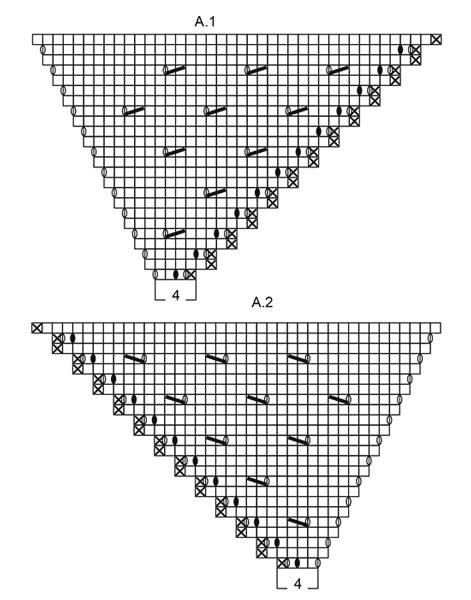
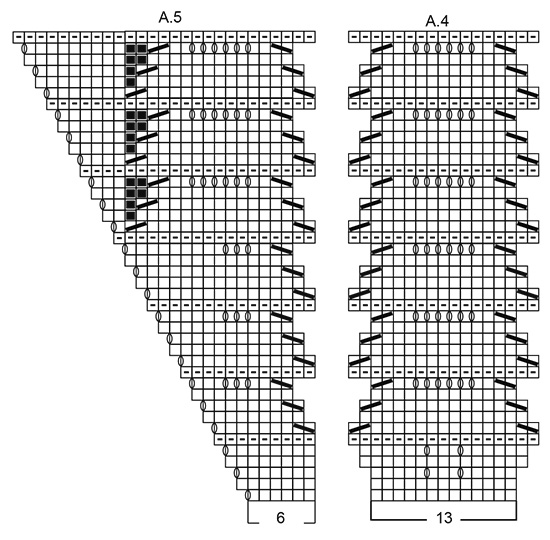
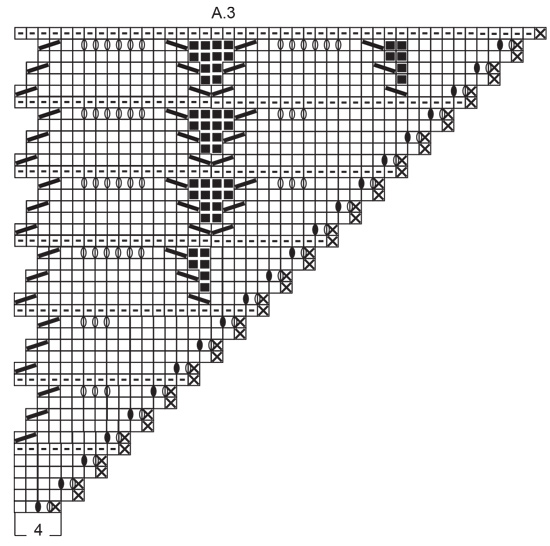
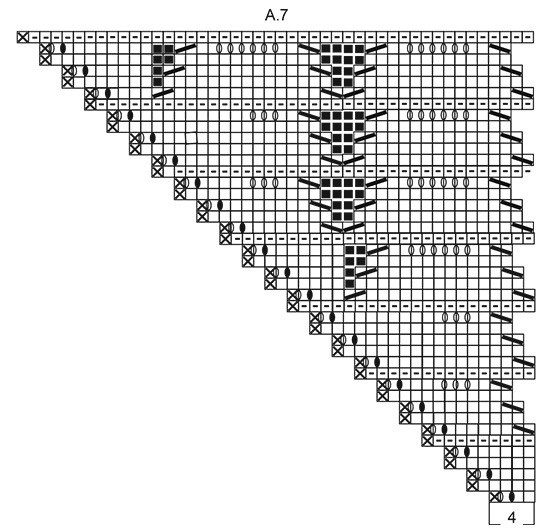
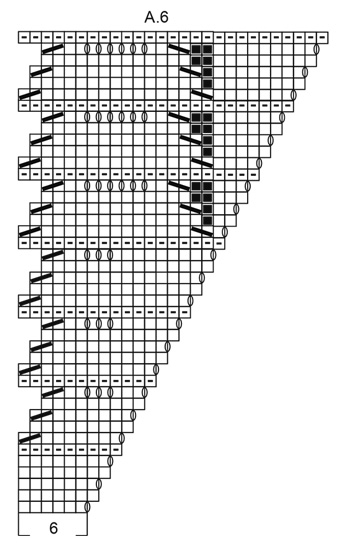
What can you do with our patterns? You can share DROPS patterns online, using the pattern original picture, materials, name and number. But you are NOT ALLOWED to reproduce the complete pattern digitally in any way. Yarn stores are welcome to use the DROPS pattern database to promote the sale of our assortment. You can print out our patterns, make as many copies as you’d like. The only thing we ask is that you don't make any changes / additions to the original printed document. And that the patterns according to the DROPS philosophy are given out to the consumers for free. Editorials that wish to publish our patterns in printed books or magazines can contact us for more information. The sale of garments based on DROPS patterns is permitted as long as they are sold as single items or per order. Further commercial use of the patterns is not permitted. It has to be clearly stated that the garment is made based on a design from DROPS DESIGN. The use of clothing labels of which DROPS DESIGN forms part is conditioned by the inclusion of the following text: “A DROPS DESIGN made by …..”. The use of DROPS photos for marketing purposes/sales is only permitted in connection with the use/sale of DROPS products. The photos may not be cut or edited and the logo should be clearly visible.
We reserve the right to withdraw the permission for use of our patterns at any time, notwithstanding the reason.
Each of our patterns has specific tutorial videos to help you.
These step-by-step tutorials might also help you:
Why is the knitting/crochet tension so important?
Knitting tension is what determines the final measurements of your work, and is usually measured per 10 x 10 cm. It is provided like so: number of stitches in width x number of rows in height - eg: 19 stitches x 26 rows = 10 x 10 cm.
The knitting tension is very individual; some people knit/crochet loosely while others work tightly. You adjust the knitting tension with the needle size, which is why the suggested needle size only serve as a guide! You need to adjust this (up or down) to ensure that YOUR knitting tension matches the knitting tension provided in the pattern. If you work with a different knitting tension than provided you will have a different yarn consumption, and your work will have different measurements than what the pattern suggests.
The knitting tension also determines which yarns can replace each other. As long as you achieve the same knitting tension you can replace one yarn with another.
See DROPS lesson: How to measure your tension/gauge
See DROPS video: How to make a gauge tension swatch
How do I know how many balls of yarn I need?
The required amount of yarn is provided in grams, eg: 450 g. To calculate how many balls you’ll need you first need to know how many grams are in 1 ball (25g, 50g or 100g). This information is available if you click on the individual yarn quality on our pages. Divide the amount required with the amount of each ball. For example, if each ball is 50g (the most common amount), the calculation will be as follows: 450 / 50 = 9 balls.
Can I use a different yarn than what the pattern suggests?
The important thing when changing from one yarn to another is that the knitting/crochet tension remains the same. This is so that the measurements of the finished piece will be the same as on the sketch provided. It is easier to achieve the same knitting tension using yarns from the same yarn group. It is also possible to work with multiple strands of a thinner yarn to achieve the knitting tension of a thicker one. Please try our yarn converter. We recommend you to always work a test swatch.
Please NOTE: when changing yarn the garment might have a different look and feel to the garment in the photo, due to individual properties and qualities of each yarn.
See DROPS lesson: Can I use a different yarn than the one mentioned in the pattern?
What are the yarn groups?
All our yarns are categorised into yarn groups (from A to F) according to thickness and knitting tension – group A contains the thinnest yarns and group F the thickest. This makes it easier for you to find alternative yarns to our patterns, should you wish to switch yarn. All yarns within the same group have a similar knitting tension and can easily replace each other. However, different yarn qualities have different structures and properties which will give the finished work a unique look and feel.
How do I use the yarn converter?
At the top of all our patterns you’ll find a link to our yarn converter, which is a helpful tool should you wish to use a different yarn than suggested. By filling in the yarn quality you wish to replace, the amount (in your size) and number of strands, the converter will present good alternative yarns with the same knitting tension. Additionally it will tell you how much you’ll require in the new qualities and whether you’ll need to work with multiple strands. Most skeins are 50g (some are 25g or 100g).
If the pattern is worked with multiple colours, every colour will have to be converted separately. Similarly, if the pattern is worked with several strands of different yarns (for example 1 strand Alpaca and 1 strand Kid-Silk) you will have to find alternatives for each, individually.
Why do you show discontinued yarns in the patterns?
Since different yarns have different qualities and textures we have chosen to keep the original yarn in our patterns. However, you can easily find options among our available qualities by using our yarn converter, or simply pick a yarn from the same yarn group.
It is possible that some retailers still have discontinued yarns in stock, or that someone has a few skeins at home that they would like to find patterns for.
The yarn converter will provide both alternative yarn as well as required amount in the new quality.
What size should I knit?
If you think it's hard to decide what size to make, it can be a good idea to measure a garment you own already and like the size of. Then you can pick the size by comparing those measures with the ones available in the pattern's size chart.
You'll find the size chart at the bottom of the pattern.
See DROPS lesson: How to read size chart
Why do I get the wrong knitting tension with the suggested needle size?
The needle size provided in the pattern serves only as a guide, the important thing is to follow the knitting tension. And since knitting tension is very individual, you will have to adjust the needle size to ensure that YOUR tension is the same as in the pattern – maybe you’ll have to adjust 1, or even 2 needle sizes, up or down to achieve the correct tension. For this, we recommend that you work test swatches.
Should you work with a different knitting tension than the one provided, the measurements of the finished garment might deviate from the measurement sketch.
See DROPS lesson: How to measure your tension/gauge
See DROPS video: How to make a gauge tension swatch
Why is the pattern worked top-down?
Working a garment top-down provides more flexibility and room for personal adjustment. For example it is easier to try the garment on while working, as well as making adjustments to length of yoke and shoulder caps.
The instructions are carefully explaining every step, in the correct order. Diagrams are adjusted to the knitting direction and are worked as usual.
How do I work according to a knitting diagram?
The diagram depicts all rows/rounds, and every stitch seen from the right side. It is read from bottom to top, from right to left. 1 square = 1 stitch.
When working back and forth, every other row is worked from the right side and every other row is worked from the wrong side. When working from the wrong side, the diagram will have to be worked reversed: from left to right, knit stitches are purled, purl stitches are knit etc.
When working in the round every round is worked from the right side and the diagram are worked from right to left on all rounds.
See DROPS lesson: How to read knitting diagrams
How do I work according to a crochet diagram?
The diagram depicts all rows/rounds, and every stitch seen from the right side. It is worked from bottom to top, from right to left.
When working back and forth every other row is worked from the right side: from right to left and every other row is worked from the wrong side: from left to right.
When working in the round, every row in the diagram are worked from the right side, from right to left.
When working a circular diagram you start in the middle and work your way outwards, counter clockwise, row by row.
The rows usually start with a given number of chain stitches (equivalent to the height of the following stitch), this will either be depicted in the diagram or explained in the pattern.
See DROPS lesson: How to read crochet diagrams
How do I work several diagrams simultaneously on the same row/round?
Instructions for working several diagrams after each other on the same row/round, will often be written like so: “work A.1, A.2, A.3 a total of 0-0-2-3-4 times". This means you work A.1 once, then A.2 is worked once, and A.3 is repeated (in width) the number of times provided for your size – in this case like so: S = 0 times, M = 0 times, L=2 times, XL= 3 times and XXL = 4 times.
The diagrams are worked as usual: begin with the first row in A.1, then work the first row in A.2 etc.
See DROPS lesson: How to read knitting diagrams
See DROPS lesson: How to read crochet diagrams
Why are the sleeves shorter in larger sizes?
The total width of the garment (from wrist-to-wrist) will be larger in the larger sizes, despite the actual sleeves being shorter. The larger sizes have longer sleeve caps and wider shoulders, so there will be a good fit in all sizes.
Where on the garment is the length measured?
The measurement sketch/schematic drawing provides information regarding the full length of the garment. If it’s a jumper or a jacket the length is measured from the highest point on the shoulder (usually closest to the neckline), and straight down to the bottom of the garment. It is NOT measured from the tip of shoulder. Similarly, the length of yoke is measured from the highest point on the shoulder and down to where yoke is split into body and sleeves.
See DROPS lesson: How to read a schematic drawing
What is a repeat?
Diagrams are often repeated on the round or in height. 1 repeat is the diagram the way it appears in the pattern. If it says to work 5 repeats of A.1 in the round, then you work A.1 a total of 5 times after/next to each other in the round. If it says to work 2 repeats of A.1 vertically/in height you work the entire diagram once, then begin again at the start and work the entire diagram one more time.
Why does the piece start with more chain stitches than it’s worked with?
Chain stitches are slightly narrower than other stitches and to avoid working the cast-on edge too tight, we simply chain more stitches to begin with. The stitch count will be adjusted on the following row to fit the pattern and measurement sketch.
Why increase before the rib edge when the piece is worked top-down?
The rib edge is more elastic and will contract slightly compared to, for example, stocking stitch. By increasing before the rib edge, you avoid a visible difference in width between the rib edge and the rest of the body.
Why increase in the cast-off edge?
It’s very easy to cast off too tightly, and by making yarn overs while casting off (and simultaneously casting these off) you avoid a too tight cast off edge.
See DROPS video: How to bind off with yarn overs (yo)
How do I increase/decrease on every 3rd and 4th row/round alternately?
To achieve an even increase (or decrease) you can increase on, for example: every 3rd and 4th row alternately, like so: work 2 rows and increase on the 3rd row, work 3 rows and increase on the 4th. Repeat this until the increase is complete.
See DROPS lesson: Increase or decrease 1 st on every 3rd and 4th row alternately
How can I work a jacket in the round instead of back and forth?
Should you prefer to work in the round instead of back and forth, you may of course adjust the pattern. You’ll need to add steeks mid-front (usually 5 stitches), and follow the instructions. When you would normally turn and work from the wrong side, simply work across the steek and continue in the round. At the end you’ll cut the piece open, pick up stitches to work bands, and cover the cut edges.
See DROPS video: How to knit steeks and cut open
Can I work a jumper back and forth instead of in the round?
Should you prefer to work back and forth instead of in the round, you may of course adjust the pattern so you work the pieces separately and then assemble them at the end. Divide the stitches for the body in 2, add 1 edge stitch in each side (for sewing) and work the front and back pieces separately.
See DROPS lesson: Can I adapt a pattern for circular needles into straight needles?
Why is the pattern slightly different than what I see in the photo?
Pattern repeats can vary slightly in the different sizes, in order to get the correct proportions. If you’re not working the exact same size as the garment in the photo, yours might deviate slightly. This has been carefully developed and adjusted so that the complete impression of the garment is the same in all sizes.
Make sure to follow instructions and diagrams for your size!
How do I make a women’s size garment into a men’s size one?
If you have found a pattern you like which is available in women’s size it’s not very difficult to convert it to men’s size. The biggest difference will be the length of sleeves and body. Start working on the women size that you think would fit across the chest. The additional length will be worked right before you cast off for the armhole/sleeve cap. If the pattern is worked top-down you can add the length right after the armhole or before the first decrease on sleeve.
Regarding additional yarn amount, this will depend on how much length you add, but it is better with a skein too many than too few.
How do I prevent a hairy garment from shedding?
All yarns will have excess fibres (from production) that might come off as lint or shedding. Brushed yarns (ie hairier yarns) have more of these loose, excess fibres, causing more shedding.
Shedding also depends on what is worn under or over the garment, and whether this pulls at the yarn fibres. It’s therefore not possible to guarantee that there will be no shedding
Below are some tips on how to get the best result when working with hairier yarns:
1. When the garment is finished (before you wash it) shake it vigorously so the looser hairs come off. NOTE: do NOT use a lint roller, brush or any method that pulls at the yarn.
2. Place the garment in a plastic bag and put it in your freezer - the temperature will cause the fibres to become less attached to each other, and excess fibres will come off easier.
3. Leave in the freezer for a few hours before taking it out and shaking it again.
4. Wash the garment according to the instructions on the yarn label.
Why does my garment pill?
Pilling is a natural process that happens to even the most exclusive of fibers. It's a natural sign of wear and tear that is hard to avoid, and that is most visible in high friction areas of your garment like a sweater's arms and cuffs.
You can make your garment look as new by removing the pilling, using a fabric comb or a pill/lint remover.
In the meantime, you can read the questions and answers that others have left to this pattern or join the DROPS Workshop on Facebook to get help from fellow knitters/crocheters!
You might also like...
High Tide |
|||||||||||||||||||||||||
 |
 |
||||||||||||||||||||||||
Knitted shawl with lace and wave pattern. The piece is worked top down in DROPS Lace.
DROPS 186-26 |
|||||||||||||||||||||||||
|
INFORMATION FOR THE PATTERN: RIDGE/GARTER STITCH (worked back and forth): 1 ridge = Knit 2 rows. PATTERN: See diagrams A.1 to A.7. The diagrams show all the rows in the pattern seen from the right side. BINDING OFF TIP To avoid the bind-off edge being tight you can make yarn overs at the same time as you bind off. Make yarn overs above all the yarn overs from the previous row with yarn overs; the yarn overs are then bind off as normal stitches. Make sure you do not tighten the strand. If the bind-off edge is still tight, you can use a larger needle size to bind off. SHAPING: If you are using another yarn from yarn group A, the shawl will not need to be stretched when finished; but dampen it and lay it flat in the right shape. Allow it to dry. Repeat this process each time the shawl is washed. ---------------------------------------------------------- SHAWL: The piece is worked back and forth with circular needle to give enough room for all the stitches. It is worked top down. Cast on 5 stitches with circular needle size 3 mm / US 2.5 and Lace. Now work the next 2 rows as follows: ROW 1 (= right side): Work 1 edge stitch in GARTER STITCH - see description above, 1 yarn over, 1 stitch in stockinette stitch, 1 yarn over, 1 stitch in stockinette stitch, 1 yarn over, 1 stitch in stockinette stitch, 1 yarn over and 1 edge stitch in garter stitch. ROW 2 (= wrong side): 2 edge stitches in garter stitch, purl until there are 2 stitches left and 2 edge stitches in garter stitch = 9 stitches on the needle. Then work according to diagrams A.1 and A.2 as follows: Work diagram A.1 over the first 4 stitches, 1 stitch in stockinette stitch (= mid-stitch - this is worked in stockinette stitch throughout the whole piece), work A.2 over the last 4 stitches. Continue working like this according to A.1 and A.2 until the diagrams have been worked 1 time in height = 81 stitches on the needle. READ THE WHOLE OF THE NEXT SECTION BEFORE CONTINUING! Now you will continue with pattern and increases in the same way as in A1 and A.2. You are increasing 2 stitches at the beginning and end of the row and increasing on each side of the mid-stitch. The row of holes is worked in the same way; it is important to make sure the rows of holes are above each other (as before) and that there are at least 5 stitches stockinette stitch on each side of the mid-stitch. Work like this until you have increased a total of 54 times and there are 333 stitches on the needle (= 166 stitches on each side of the mid-stitch). Now continue as follows on the next row from the right side: Work diagram A.3 over 4 stitches, repeat diagram A.4 over the next 156 stitches (= 12 repeats in width), work A.5 over 6 stitches, 1 stitch in stockinette stitch (= mid-stitch), A.6 over 6 stitches, repeat diagram A.4 over the next 156 stitches (= 12 repeats in width), work A.7 over the last 4 stitches. Work the diagrams like this 1 time in height = 555 stitches on the needle. Work 2 ridges. READ BINDING OFF TIP and bind off with knit on the next row. Cut and fasten the strand. STRETCHING: Place the shawl in luke-warm water until it is thoroughly wet. Press the water carefully out of the shawl - do not twist the garment, then roll the shawl in a towel and press to remove even more water - the shawl should just be damp. If you have used another yarn from yarn group A, read SHAPING above. Lay the shawl on a floor rug or mattress - pull it gently into shape and use pins to fasten it down. Allow the shawl to dry. Repeat the process each time the shawl is washed. |
|||||||||||||||||||||||||
Diagram explanations |
|||||||||||||||||||||||||
|
|||||||||||||||||||||||||

|
|||||||||||||||||||||||||

|
|||||||||||||||||||||||||

|
|||||||||||||||||||||||||

|
|||||||||||||||||||||||||

|
|||||||||||||||||||||||||
|
Have you made this or any other of our designs? Tag your pictures in social media with #dropsdesign so we can see them! Do you need help with this pattern?You'll find tutorial videos, a Comments/Questions area and more by visiting the pattern on garnstudio.com. © 1982-2024 DROPS Design A/S. We reserve all rights. This document, including all its sub-sections, has copyrights. Read more about what you can do with our patterns at the bottom of each pattern on our site. |
|||||||||||||||||||||||||
With over 40 years in knitting and crochet design, DROPS Design offers one of the most extensive collections of free patterns on the internet - translated to 17 languages. As of today we count 304 catalogs and 11422 patterns - 11417 of which are translated into English (US/in).
We work hard to bring you the best knitting and crochet have to offer, inspiration and advice as well as great quality yarns at incredible prices! Would you like to use our patterns for other than personal use? You can read what you are allowed to do in the Copyright text at the bottom of all our patterns. Happy crafting!








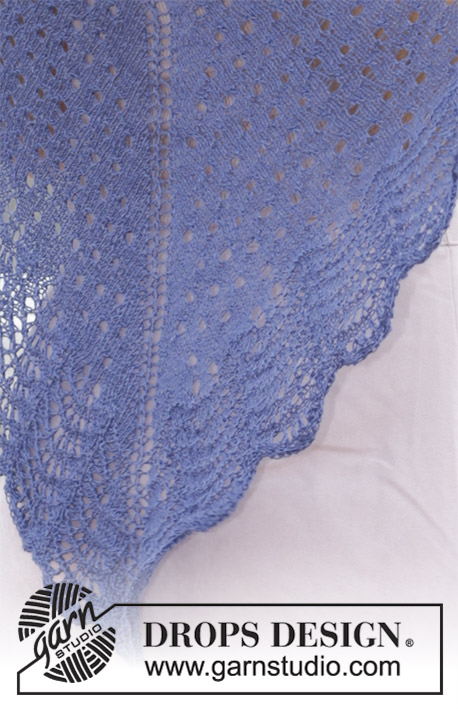

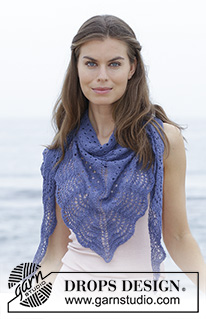

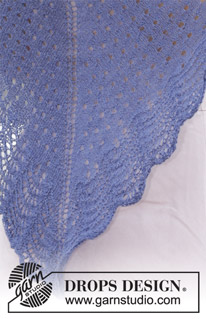
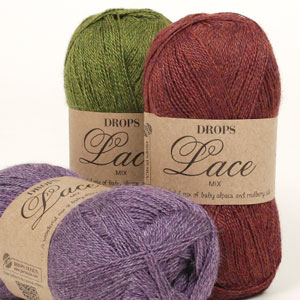



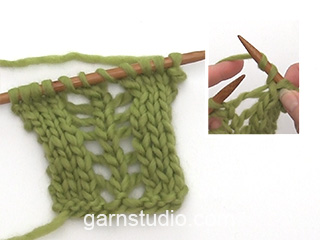


























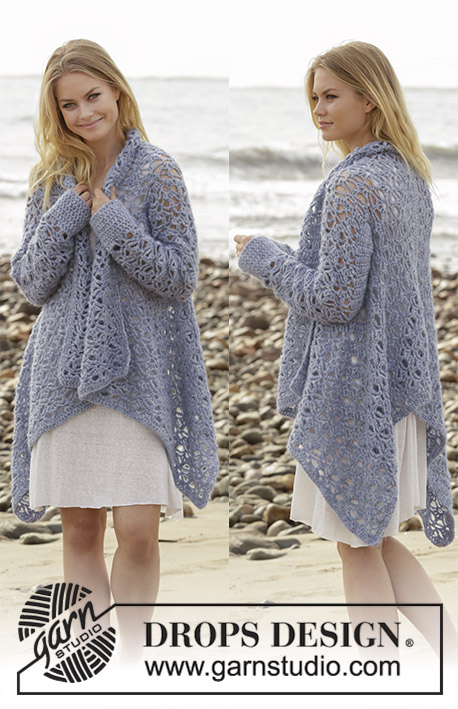
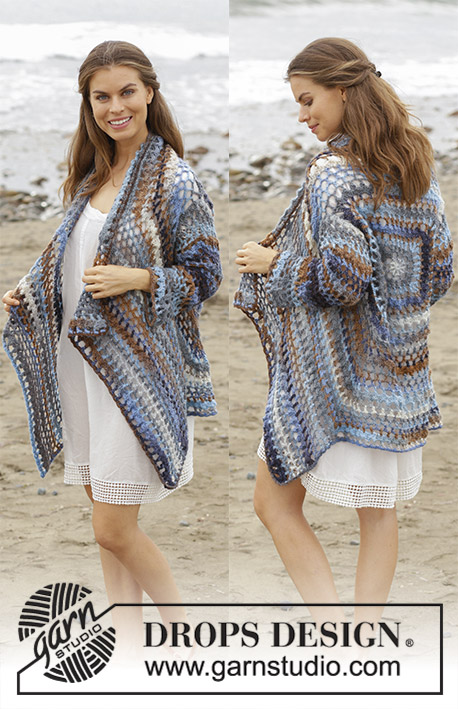
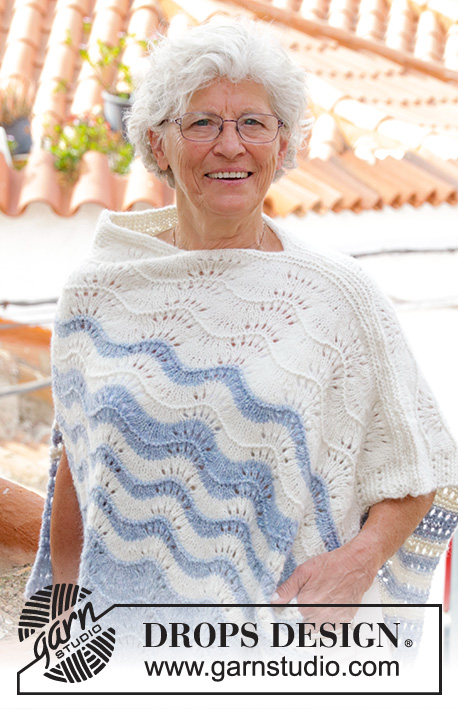






Comments / Questions (42)
Nel diagramma, nessuna maglia vuol dire passata a dritto? Come altrimenti salto il quadrato? Grazie
08.02.2019 - 15:46DROPS Design answered:
Buongiorno Rita. Deve lavorare la maglia successiva sul ferro come indicato nel primo quadrato non nero (dopo quelli neri) nel diagramma. P.es: se dopo il quadrato nero trova un quadrato bianco e sta lavorando sul diritto del lavoro, lavora la maglia successiva a diritto. Buon lavoro!
08.02.2019 - 16:17Grazie, adesso ho capito!!!
31.01.2019 - 13:26Ho cominciato questo scialle dalla foto bellissimo a mi sembra che la spiegazione non corrisponda!! Viene cominciato dalla punta centrale giusto....
29.01.2019 - 23:08DROPS Design answered:
Buongiorno Rita. Lo scialle ha inizio dalla parte centrale, in alto. Si inizia quindi con la parte lavorata a maglia rasata con i buchi (diag. A1 e A2) e si procede verso la punta in basso seguendo gli altri diagrammi come indicato. Buon lavoro!
30.01.2019 - 06:44Hej! Är rättelserna gjorda på mönstersidan efter insändaren om fel från den 7.12.2018? Sjalen är ju så fin och den behöver jag sticka NU.... ✊🏻
13.01.2019 - 23:04DROPS Design answered:
Hei Lena. Ja diagrammene ble oppdatert 7.12.2018. God fornøyelse
16.01.2019 - 15:03Hej! Jag har problem med diagram A3 och A7, nämligen följande: Varv 11 startar med tolv maskor, sedan ökas fyra med omslag och minskas 1, vilket gör att efter varv 11 finns 15 maskor på stickan. Varv 12 börjar dock med 16 maskor. Hur hänger det ihop? Tacksam för snabbt svar! /Kajsa
07.12.2018 - 08:35DROPS Design answered:
Hei Kajsa. Du har helt rett i at dette ikke går opp. Her mangler det 1 kast. Det skal altså være 3 kast etter hverandre, sånn som på rad 17. Omgang 11 av A.3 strikkes slik: 1 vrang, 1 kast, 1 rett, 1 sort kast, 4 rett, 1 kast, 1 rett, 1 kast, 1 rett, 1 kast, 2 rett, 2 rett sammen. A.7 strikkes likt, men motsatt rekkefølge. Vi skal få rettet dette i diagrammet snarest. Takk for beskjed og god fornøyelse
07.12.2018 - 09:40Katerina wrote:
Could i find instructions about this pattern in greek? unfortunately my mum doesn't understand english. Thank you in advance.
23.10.2018 - 19:49DROPS Design answered:
Hi Katerina, Unfortunately we have not translated this pattern into Greek. Hopefully we will be able to do so in the not too distant future. Kind regards.
24.10.2018 - 07:57Hallo, ich bin gerade dabei dieses Tuch zu stricken, nur leider verwirrt mich ein Teil der Anleitung. Ich habe bereits Diagramm A.1 und A.2 gestrickt, habe also nun genau 81 Maschen auf der Rundnadel. Der nächste Absatz ist mir unklar; könnt ihr das nochmal einfacher erklären? Oder muss ich einfach nur nochmal A.1 und A.2 stricken? Ich bin leider ratlos ohne Diagramm. Liebe Grüße und danke
15.07.2018 - 14:07DROPS Design answered:
Liebe Melanie, nachdem Sie A.1 und A.2 einmal in der Höhe gestrickt haben, stricken Sie weiter wie in A.1 und A.2 (= mit den Zunahmen am Anfang bzw am Ende A.1/A.2, dh am Anfang und am Ende der Reihe sowie auf beiden Seiten der mittleren Maschen und das Lochmuster wie zuvor wiederholen) bis Sie 333 M (= 166 M auf beiden Seiten der mittleren M) auf der Nadel haben. Viel Spaß beim stricken!
16.07.2018 - 09:11Hallo, ik heb deze sjaal gebreid op nld 3 met Katia jaipur. Precies het patroon gevolgd, maar in de golven zie je bijna de gaten niet en de gaatjes daarboven zijn ook veel compacter. Hier lijkt het begin horizon taal te lopen, bij mij blijft het een punt. Heel jammer, want nu heeft het niet de uitstraling die ik ervan verwacht had. Ik heb het patroon voorgelegd aan dames die veel kennis hebben en ook zij zeggen dat ik het patroon goed uitgevoerd heb maar niet overeen komt met de foto.
11.07.2018 - 12:26Hei! Puuttuukohan piirroksista A.3 ja A.7 riviltä 11 yhdet lisäykset? En saa silmukkamäärä täsmäämään.
05.07.2018 - 20:51Bonjour , je ne comprends pas bien le début du tricot je m explique le patron A1et A2 se font à partir des 4 mailles, cela je le comprends. Ce sont les augmentations (54) donc 2augmentations de chaque côté deA1 et A2 donc les augmentations se font sur l endroit donc sur 12 rangs donc on a ajouter 48 mailles dans A1et A2 et il faut ajouter 5 mailles de chaque côté de la mailles central je n arrive pas dans le décompte des 54 augmentations . Merci de m idée
21.05.2018 - 15:45DROPS Design answered:
Bonjour Mireille, on augmente tous les 2 rangs: 2 m au début de A.1 et 2 m au début de A.2 (= 2 x 12 m x 2 diagrammes = 48 augmentations au total) et 1 m à la fin de A.1 et 1 m à la fin de A.2 (= 1 m de chaque côté de la m centrale soit 2 x 12 m = 24 augmentations au total). On avait 9 m + 48 + 24 = 81 m. Bon tricot!
22.05.2018 - 09:39